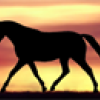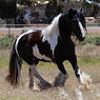Sooty and Dun (New pics pg 2!) :D
Forums
Re: Sooty and Dun (New pics pg 2!) :D
If that's what you've been meaning this entire time, I am dreadfully embarrassed LOL. And I apologize for any grey hairs I may have caused. It could explain why we see growing dun factor as the horses ages, it's just the growing sooty pattern expressing through in areas that dun allows.
Re: Sooty and Dun (New pics pg 2!) :D
[quote="Threnody"]Since dun dilutes both red and black pigment it likely just causes sooty to be hidden through dilution. [/quote]
Yes! That's exactly what I figure dun is doing! Like you said too JNF, the sooty just shows up where the dun factor/markings are. So a more sooty base could have darker dun factor compared to a less sooty base perhaps.
Re: Sooty and Dun (New pics pg 2!) :D
[quote="RiddleMeThis"]IMO if dun was just diluting the sooty, you would still see it as IMO dun is going to dilute whereever it dilutes X amount. It's not going to dilute the barrel X% but then on the barrel where there would be sooty dilute it Y% so it matches.[/quote]
Those horses with the clean barrels may not be sooty then. From what I've seen of sooty, it gradually is expressed as the horse ages, some more quickly then others.




Re: Sooty and Dun (New pics pg 2!) :D
That's what I've thought too JNFerrigno.
Since dun dilutes both red and black pigment it likely just causes sooty to be hidden through dilution. Dun can make regular bay horses look like they have a wild bay base because the leg black gets so diluted.